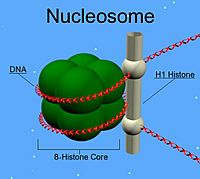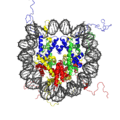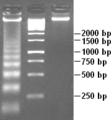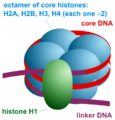Nucleosome facts for kids
Nucleosomes are tiny structures inside your cells. Think of them as spools that help organize very long strands of DNA. They are the basic building blocks that make up chromosomes. Each nucleosome is made of a piece of DNA wrapped around special histone proteins.
First, DNA and proteins combine to form something called chromatin. Then, this chromatin is carefully folded and packed into nucleosomes. These nucleosomes are then packed even tighter to create a chromosome. This clever packing does three important things:
- It helps chromosomes work correctly during cell division.
- It neatly stores the very long DNA in a much smaller space.
- The proteins in nucleosomes help control how genes work in your cells.
What are Nucleosomes?
Nucleosomes are the main repeating units found in the chromatin of eukaryotic cells. Eukaryotic cells are the cells that make up plants, animals, fungi, and protists. This special packing helps fit the huge amount of DNA inside the nucleus of a cell. It also helps control how the DNA is used.
For example, in mammalian cells, about two meters of DNA need to fit into a tiny nucleus, which is only about 10 micrometers wide! Nucleosomes fold up into even higher structures to form a chromosome. This folding makes the DNA compact and also adds a way to control which genes are active. This control makes sure the right genes are turned on or off at the right time.
Scientists also believe that nucleosomes carry information that can be passed down from parent cells to daughter cells. This information is not in the DNA code itself, but in changes to the histone proteins. This is part of something called Epigenetics. This information can be passed on when cells divide, but it usually gets reset during meiosis in germ cells.
The idea of nucleosomes was first suggested by Don and Ada Olins and Roger D. Kornberg in 1974. This was a huge step in understanding how genes work in eukaryotic cells. Roger Kornberg later won the Nobel Prize in Chemistry in 2006 for this and other important discoveries.
How Nucleosomes Move and Change
Even though a nucleosome is a very stable combination of proteins and DNA, it's not completely still. It can change its shape and position. For example, nucleosomes can slide along the DNA or expose different parts of the DNA. These movements can either stop or help the process of transcription, which is when DNA is copied into RNA.
Since they were discovered in the 1960s, scientists have thought that changes to histones could affect how genes are copied.
Some changes to histones are linked to genes being "silenced" or turned off. Other changes seem to be linked to genes being "activated" or turned on. The information stored in this way is called epigenetic. It's not written in the DNA code itself, but it can still be passed down to new cells. Keeping a gene in a certain state is often very important for cellular differentiation, which is how cells become specialized for different jobs in the body.
Images for kids
-
The crystal structure of the nucleosome core particle (PDB 1EQZ).
See also
 In Spanish: Nucleosoma para niños
In Spanish: Nucleosoma para niños







